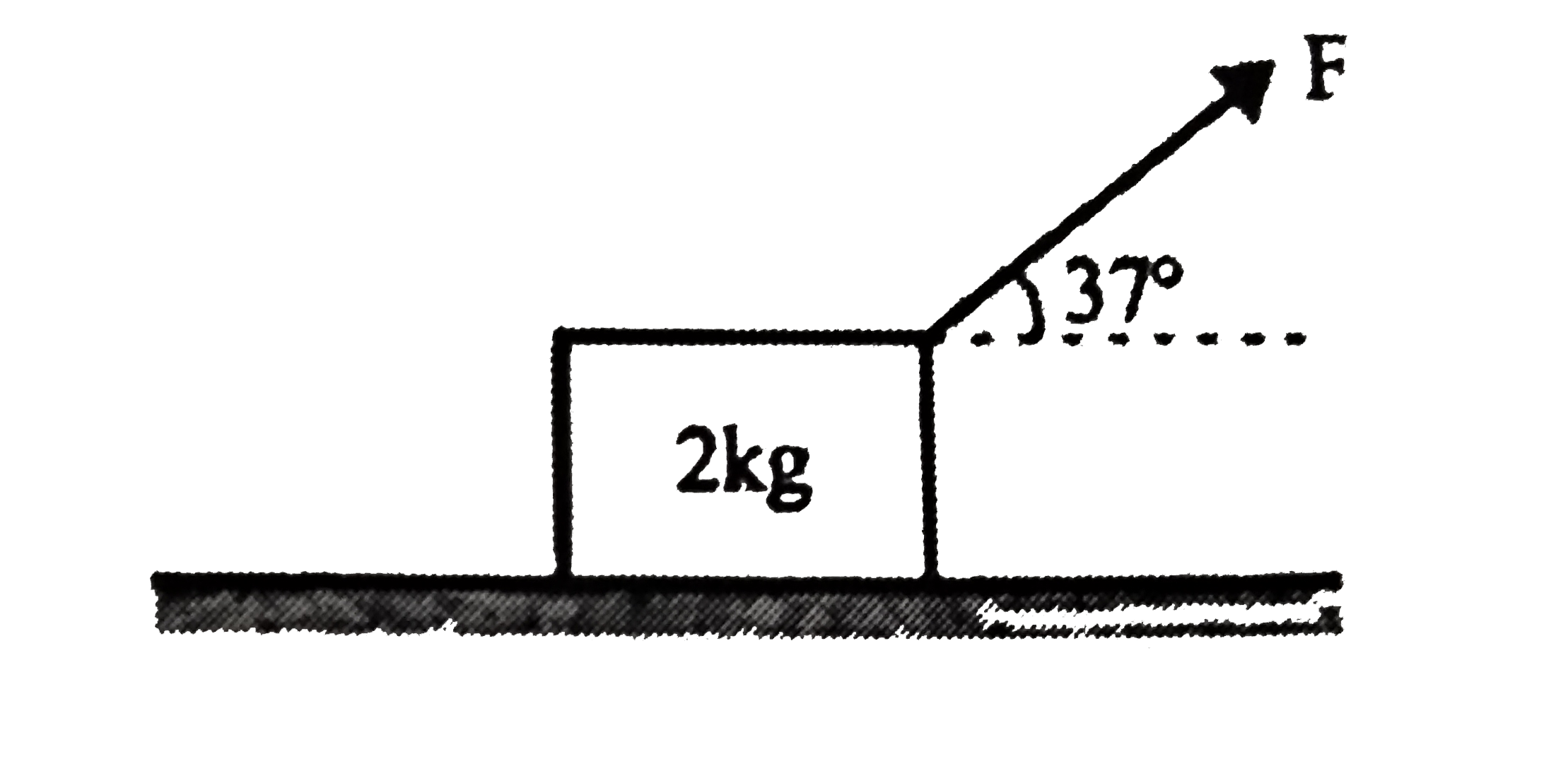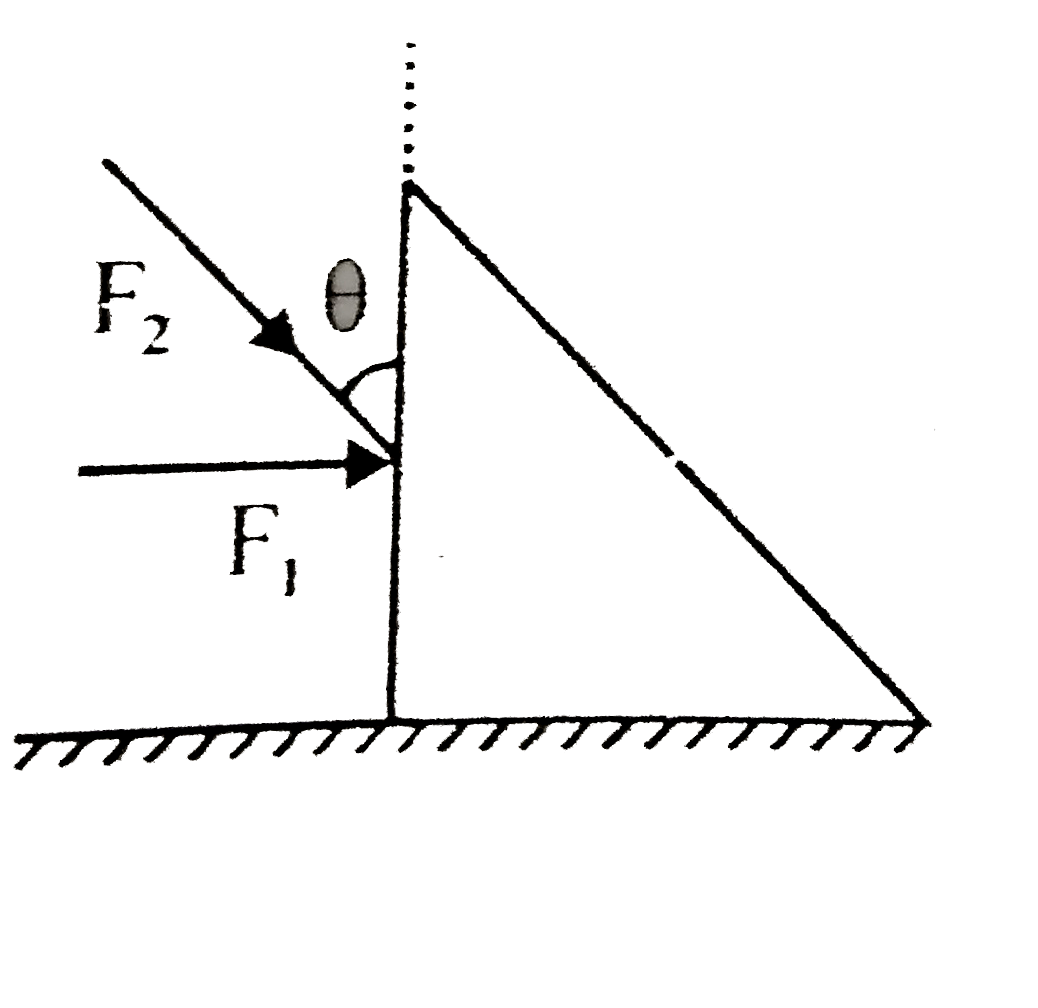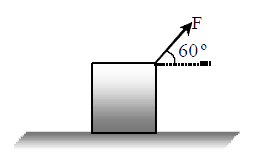A heavy box is to be dragged along a rough horizontal floor. To do so, person A pushes it at an angle 30∘ from the horizontal and requires a minimum force FA, while person B pulls the box at angle 60∘ from the horizontal and needs minimum force FB. If the coefficient of friction between the box and the floor is √35 , the ratio is FAFB
√3
5√3
√32
2√3
The correct Answer is:d
To solve the problem, we need to find the ratio FAFB where FA is the force required by person A to push the box at an angle of 30∘ and FB is the force required by person B to pull the box at an angle of 60∘. The coefficient of friction μ is given as √35.
Step 1: Analyze the forces for person A (pushing)
When person A pushes the box at an angle of 30∘:
- The horizontal component of the force FA is FAcos(30∘).
- The vertical component of the force FA is FAsin(30∘).
The normal force NA acting on the box can be expressed as:
NA=mg+FAsin(30∘)
where mg is the weight of the box.
The limiting friction FL is given by:
FL=μNA=√35(mg+FAsin(30∘))
For the box to move, the horizontal component of the pushing force must overcome the limiting friction:
FAcos(30∘)=FL
Substituting for FL:
FAcos(30∘)=√35(mg+FAsin(30∘))
Step 2: Substitute values for angles
Using cos(30∘)=√32 and sin(30∘)=12:
FA⋅√32=√35(mg+FA⋅12)
Step 3: Rearranging the equation
Multiply through by 10 to eliminate the fractions:
5√3FA=2√3(mg+12FA)
Distributing the right side:
5√3FA=2√3mg+√3FA
Rearranging gives:
5√3FA−√3FA=2√3mg
4√3FA=2√3mg
Dividing both sides by 4√3:
FA=mg2
Step 4: Analyze the forces for person B (pulling)
When person B pulls the box at an angle of 60∘:
- The horizontal component of the force FB is FBcos(60∘).
- The vertical component of the force FB is FBsin(60∘).
The normal force NB acting on the box can be expressed as:
NB=mg−FBsin(60∘)
The limiting friction FL is given by:
FL=μNB=√35(mg−FBsin(60∘))
For the box to move, the horizontal component of the pulling force must overcome the limiting friction:
FBcos(60∘)=FL
Substituting for FL:
FBcos(60∘)=√35(mg−FBsin(60∘))
Step 5: Substitute values for angles
Using cos(60∘)=12 and sin(60∘)=√32:
FB⋅12=√35(mg−FB⋅√32)
Step 6: Rearranging the equation
Multiply through by 10 to eliminate the fractions:
5FB=2√3(mg−√32FB)
Distributing the right side:
5FB=2√3mg−3FB
Rearranging gives:
5FB+3FB=2√3mg
8FB=2√3mg
Dividing both sides by 8:
FB=√34mg
Step 7: Find the ratio FAFB
Now we can find the ratio:
FAFB=mg2√34mg
Cancelling mg from the numerator and denominator:
FAFB=1/2√3/4=42√3=2√3
Final Answer
The ratio FAFB is 2√3.
- The horizontal component of the force FA is FAcos(30∘).
- The vertical component of the force FA is FAsin(30∘).
NA=mg+FAsin(30∘)
where mg is the weight of the box.
FL=μNA=√35(mg+FAsin(30∘))
FAcos(30∘)=FL
Substituting for FL:
FAcos(30∘)=√35(mg+FAsin(30∘))
FA⋅√32=√35(mg+FA⋅12)
5√3FA=2√3(mg+12FA)
Distributing the right side:
5√3FA=2√3mg+√3FA
Rearranging gives:
5√3FA−√3FA=2√3mg
4√3FA=2√3mg
Dividing both sides by 4√3:
FA=mg2
- The horizontal component of the force FB is FBcos(60∘).
- The vertical component of the force FB is FBsin(60∘).
NB=mg−FBsin(60∘)
FL=μNB=√35(mg−FBsin(60∘))
FBcos(60∘)=FL
Substituting for FL:
FBcos(60∘)=√35(mg−FBsin(60∘))
FB⋅12=√35(mg−FB⋅√32)
5FB=2√3(mg−√32FB)
Distributing the right side:
5FB=2√3mg−3FB
Rearranging gives:
5FB+3FB=2√3mg
8FB=2√3mg
Dividing both sides by 8:
FB=√34mg
FAFB=mg2√34mg
Cancelling mg from the numerator and denominator:
FAFB=1/2√3/4=42√3=2√3
The ratio FAFB is 2√3.
Topper's Solved these Questions
- INTRODUCTION TO VECTORS & FORCES Book:VMC MODULES ENGLISHChapter:INTRODUCTION TO VECTORS & FORCES Exercise:JEE Advanced ( ARCHIVE LEVEL-2)
Explore 12 Videos
- INTRODUCTION TO VECTORS & FORCES Book:VMC MODULES ENGLISHChapter:INTRODUCTION TO VECTORS & FORCES Exercise:level 2
Explore 65 Videos
- GRAVITATIONBook:VMC MODULES ENGLISHChapter:GRAVITATIONExercise:JEE Advance (Archive) TRUE/FALSE
Explore 1 Video
- JEE MAIN - 5Book:VMC MODULES ENGLISHChapter:JEE MAIN - 5Exercise:PART I : PHYSICS (SECTION - 2)
Explore 5 Videos
Similar Questions
A block of mass 2 kg is kept on a rough horizontal floor an pulled with a force F. If the coefficient of friction is 0.5. then the minimum force required to move the block is :-

View SolutionA horizontal force F pulls a 20 kg box at a constant speed along a rough horizotal floor. The coefficient of friction between the box and the floor is 0.25. The work done by force F on the block in displacing it by 2 m is
View SolutionA wooden block of mass M resting on a rough horizontal surface is pulled with a force T at an angle q to the horizontal. If m is coefficient of kinetic friction between the block and the surface, the acceleration of the block is
View SolutionA block of weight 200N is pulled along a rough horizontal surface at constant speed by a force 100N acting at an angle 30∘ above the horizontal. The coefficient of friction between the block and the surface is
View SolutionA body of weight 20N is on a horizontal surface, minimum force applied to pull it when applied force makes an angle 60° with horizontal (angle of friction a = 30°) is
View Solution
A wedge of mass m, lying on a rough horizontal plane, is acted upon by a horizontal force F1 and another force F2, inclined at an angle θ to the vertical. The block is in equilibrium, then minimum coefficient of friction between it and te surface is
View SolutionFind the minimum value of horizontal force (F) required on the block of mass m to keep it at rest on the wall. Given the coefficient of friction between the surfaces is μ.
View SolutionA force is inclined at an angle of 60∘ from the horizontal. If the horizontal component of the force is 40N,calculate the vertical component.
View SolutionA force is inclined at an angle of 60∘ from the horizontal. If the horizontal component of the force is 4N,calculate the vertical component.
View SolutionA child pulls a box with a force of 200 N at an angle of 60∘ above the horizontal. Then the horizontal and vertical components of the force are-

View Solution